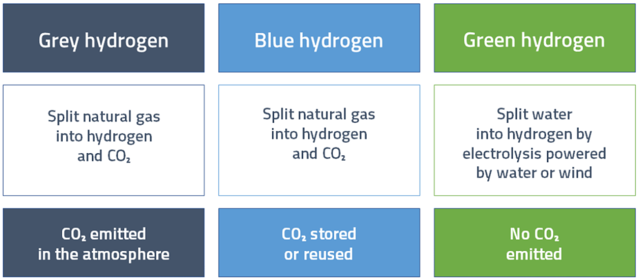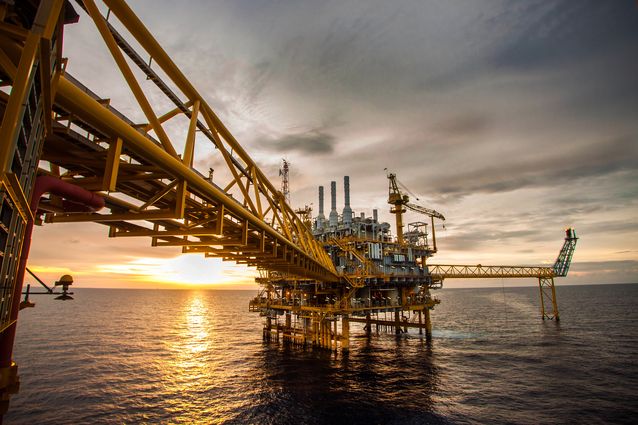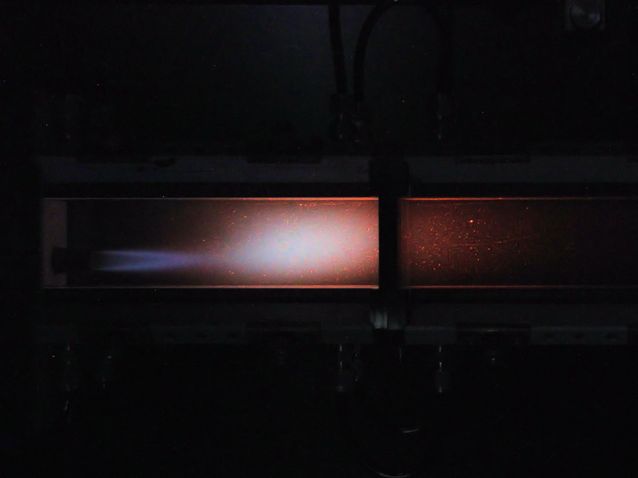The new European Commission is planning a European Green Deal. The goal is to create the first climate-neutral continent by 2050. This cannot happen without using much more hydrogen than at the moment because hydrogen is a zero-emission fuel when burned with oxygen. However, not all forms of hydrogen are alike. We need to shift from grey hydrogen, the production of which causes CO₂ emissions, to climate-neutral green hydrogen. Blue hydrogen, which is produced using carbon capture solutions, can provide at least an intermediate solution during the process of transitioning away from grey hydrogen.
The President of the next European Commission, Ursula von der Leyen, has said she will propose a European Green Deal in her first 100 days in office [1]. The goal is to achieve climate neutrality in the EU by 2050. Every person and every sector will have to contribute for the EU to reach this goal.
The European Turbine Network ETN is writing a white paper about the role of the industry in reaching the EU goal. Aurelia Turbines and other ETN members see the growing use of hydrogen as a fuel vital for European climate neutrality. Despite the challenges I discussed in my previous article, hydrogen provides a practical way to transfer and store renewable energy.
Hydrogen is not a source of energy but an energy carrier that is derived from a source of energy. There are different ways to produce hydrogen industrially that have radically different impacts on the climate.
Grey, blue, green – and even brown hydrogen
Grey hydrogen is hydrogen produced using fossil fuels. It is mostly obtained from natural gas in an energy-guzzling process that is known as steam methane reforming (SMR). In SMR, steam (water vapour) is mixed with natural gas, which reacts with the methane and breaks the gas down into carbon monoxide and hydrogen. [2]
To a lesser extent, hydrogen is also produced from petroleum and coal. Sometimes this or all hydrogen produced using fossil fuels may also be referred to as brown hydrogen.
These processes release a significant amount of CO₂. Grey hydrogen accounts for some 95% of the hydrogen produced in the world today.

Blue hydrogen is hydrogen that meets the low-carbon threshold but is generated using non-renewable energy sources such as natural gas. Natural gas is decarbonised with Carbon Capture, Utilisation and Storage (CCUS) solutions during SMR. It is also possible to decarbonise methane of natural gas into hydrogen by decomposing it to solid carbon and gaseous hydrogen without producing carbon dioxide. This can be done for example through decomposition, namely the thermal treatment of methane in the absence of oxygen [3]. Because blue hydrogen is not inherently carbon-free, the production requires carbon-dioxide (CO₂) monitoring, verification, and certification [4].
Green hydrogen is hydrogen that not only meets the low-carbon threshold but is generated using renewable energy sources such as solar or wind. It is an ideal solution, especially now that the price of wind and solar energy has been decreasing. Today, less than 0.1% of global dedicated hydrogen production comes from water electrolysis.
No future for grey hydrogen
Hydrogen is already used industrially at a large scale, especially in ammonia production for fertilisers, in methanol production for plastics and pharmaceutical industries, for removing sulphur from fuels, and in steel production. Grey hydrogen has been useful for creating industrial applications and markets for hydrogen. However, in the long run, the grey hydrogen process is not a viable or environmentally sound way to produce hydrogen.
According to the IEA, 6% of global natural gas and 2% of global coal are currently going towards hydrogen production. As a consequence, the production of hydrogen is responsible for CO₂ emissions of around 830 million tons of carbon dioxide per year, equivalent to the CO₂ emissions of the United Kingdom and Indonesia combined. [5] Natural gas extraction also causes large emissions of methane, one of the most potent greenhouse gas [6].
At the moment, grey hydrogen produced from natural gas is the most commonly used because it is the cheapest to produce. Its price is estimated to be around EUR 1.50 per kilo [7]. Fuel costs are the largest cost component, accounting for between 45% and 75% of production costs as estimated by the IEA. However, as the IEA estimates, the price of natural gas will rise in the future. More importantly, the emissions trading system will markedly increase the future price. Emissions trading alone may increase the price by over 30%.
Another reason is public support. The future of hydrogen cannot be grey - and it especially cannot be brown - because people simply no longer accept fuels that emit CO₂. You can expect that trend only to continue in the coming years. Both consumers and politicians will resist the development of businesses based on hydrogen if it remains grey.

Emission trade makes blue hydrogen more competitive
Oil and gas producers are pushing increased use of blue hydrogen [8]. The blue method would allow a cost-efficient means of producing electricity from hydrogen by firing it in converted natural-gas-fired power plants, and a large number of CCUS-equipped blue hydrogen producing plants would make CCUS infrastructure shared with other industry more viable. It sounds good.
The emissions trading system is making blue hydrogen more competitive and increasing interest in developing CCUS technology. Even though the price of natural gas is rising, which affects production costs for blue carbon in the same way as for grey hydrogen, with CCUS, emission trading costs may be avoided.
At the moment, CCUS costs some EUR 50 to EUR 70 per ton of CO₂. In ammonia production and some other cases, the price is lower.
Even though blue hydrogen is pricier than grey, the difference may grow smaller and even reverse if the price of CO₂ emissions rises – however, we cannot take granted the rise of the carbon permit prices. The price of CCUS will decrease in the future because the plants will be scaled up and standardized.
However, the basic problem - CO₂ - remains. Blue hydrogen can help to slow climate change only if the captured CO₂ is reused or stored forever. In any case, we still have the greenhouse gas emissions from natural gas production.
Blue hydrogen also requires time to develop into a large-scale option. There are currently some industrial facilities around the world that use this process, and more are in the pipeline, but a much greater number is required to make a significant impact.
Green hydrogen gets cheaper with cheaper renewable energy
The price of green hydrogen is still high. Electrolysis is almost twice as expensive as hydrogen production from natural gas. However, the price is rapidly going down. The global capacity for electrolysis is growing fast. The technology is being developed and the industry is scaling up.
Most of all, the price of renewable energy is going down. Wherever you have lots of wind or sunshine as well as water, you may also have interesting opportunities for hydrogen production. The fact that the sun is not always shining and wind not always blowing is not an obstacle to hydrogen production. On the contrary, this is exactly the reason why green hydrogen is well suited for storing energy from renewable sources.
Naturally, the emissions trade is making green hydrogen more interesting. The whole trading system has been created to push forward energy solutions like green hydrogen.

We can see the trend growing
In the last few months, several new projects have been announced that confirm that the times are changing for hydrogen.
Today, Europe’s biggest water electrolyser is at Nouryon in Norway. The total installed capacity in Norway is only 10 megawatts, with a production of up to 1 500 tons of hydrogen per year. Something much larger is on its way. [9]
The Port of Rotterdam has partnered with BP and Nouryon to develop a hydrogen plant. The plant should be able to produce 45 000 tonnes of green hydrogen annually. The final decision will be taken in 2022 – unfortunately, the decision cycles are long. There should also be 12 Gigawatts in offshore wind energy in the Dutch section of the North Sea by 2030. However, this entire capacity is still not enough to meet the demand for green electricity and hydrogen for Rotterdam alone. [9]
The city of Hamburg in Northern Germany aims to become home to the world's largest hydrogen electrolysis plant. The capacity would be 100 megawatts. The final decision of whether to construct the facility in the port area will be taken by the end of 2019. The plant, running on electricity from wind turbines, would be able to produce approx. 22 000 cubic metres of hydrogen per hour. [10]
Globally, Japan is one of the leaders in building a hydrogen-based society. It will show off progress in 2020 when Tokyo hosts the Summer Olympics. In addition to a range of vehicles with a hydrogen fuel cell system, we will see the world’s first Olympic Village powered by hydrogen. [11]
Australia is currently investigating opportunities to build its largest hydrogen production plant. A 10 MW or larger hydrogen production demonstration plant would be constructed in Central Queensland. [12]
The way to a green hydrogen economy
Hydrogen is important for our future. The ideal hydrogen is green, and we need to aim for that.
However, first of all, producing green hydrogen on a large scale will require additional wind and solar capacity. According to the IEA, producing all of today’s dedicated hydrogen output from electricity would result in electricity demand of 3 600 TWh, more than the total annual electricity generation of the European Union. Both the Green Deal and green hydrogen require big investments in the use of renewable energy sources. Building that will take not only money but also time. Blue hydrogen produced from natural gas with CCUS could provide an intermediate solution.

Secondly, as von der Leyen points out, to reach this goal we will work to decarbonise energy-intensive industries. Many companies are already making plans to switch to hydrogen and then from another colour of hydrogen to green. For instance, the world's biggest steel producing company, ArcelorMittal, is planning to build a demonstration plant in Hamburg that will produce approx. 100 000 tons of direct reduced iron per year. Initially, the steel will be made with grey hydrogen sourced from natural gas. However, the company has already announced that conversion to green hydrogen from renewable energy sources will take place once available in sufficient quantities and at an economical cost. The plant will be the world’s first direct reduction plant on an industrial scale, powered by hydrogen.[13] SSAB, a global steel company based in the Nordic Countries, has proposed plans to transition the business to fossil-free steel production using hydrogen. SSAB is on its way to convert the blast furnaces in Oxelösund and Luleå In Sweden as well as the blast furnace in Raahe, Finland. [14]
Thirdly, we need to be ready to adjust our natural gas distribution network. Hydrogen can be distributed more easily and cost-effectively than we usually think. We can use the vast European natural gas grid serving energy-intensive industries, households, and transport by mixing natural gas and hydrogen [15]. In the very long run, we can even plan to switch the gas in the grid totally to hydrogen. However, this may require some additional investments, especially in enlarging the grid.
---------------------------------------------------------------------------------------
- https://ec.europa.eu/commission/sites/beta-political/files/political-guidelines-next-commission_en.pdf
- https://www.delta.tudelft.nl/article/how-clean-hydrogen-really
- https://www.advancedsciencenews.com/decarbonizing-natural-gas-methane-fuel-without-carbon-dioxide
- https://www.irena.org/publications/2019/Sep/Hydrogen-A-renewable-energy-perspective
- https://www.iea.org/hydrogen2019
- https://www.pv-magazine-australia.com/2019/09/19/the-world-has-no-chance-of-beating-climate-change-if-natural-gas-is-part-of-the-mix
- https://www.iea.org/newsroom/news/2019/april/the-clean-hydrogen-future-has-already-begun.html
- https://www.iogp.org/blog/benefits-of-oil-and-gas/opinions/blue-hydrogen-a-no-brainer-for-europe
- https://safety4sea.com/eus-biggest-hydrogen-plant-to-be-constructed-in-rotterdam
- https://www.cleanenergywire.org/news/hamburg-wants-build-worlds-largest-hydrogen-plant
- https://www.shell.com/inside-energy/japan-tokyo-olympics-hydrogen.html
- https://www.thechemicalengineer.com/news/australia-investigates-building-its-largest-hydrogen-production-plant
- http://www.refwin.com/news/NewsDetail?type=1&id=12850
- https://www.gasworld.com/plans-for-a-hydrogen-powered-steel-plant-/2014151.article
- https://www.ise.fraunhofer.de/en/key-topics/digital-energy-transformation/hydrogen-injection-part-of-electrolysis-business-models.html
